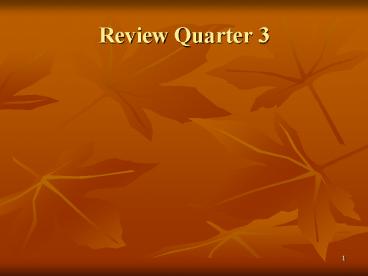Review Quarter 3 - PowerPoint PPT Presentation
Title:
Review Quarter 3
Description:
Review Quarter 3 Ecology Terms Punctuated equilibrium In the fossil record, long periods of apparent stasis (equilibrium), in which a species undergoes little or ... – PowerPoint PPT presentation
Number of Views:95
Avg rating:3.0/5.0
Title: Review Quarter 3
1
Review Quarter 3
2
Ecology
3
Terms
- Punctuated equilibrium In the fossil record,
long periods of apparent stasis (equilibrium), in
which a species undergoes little or no
morphological change, interrupted by relatively
brief periods of sudden change. - Epiphytic plant a plant that nourishes itself
but grows on the surface of another plant for
support (often on trunks of tropic plants)
4
Terms
- Ecological niche sum total of an organisms use
of biotic and abiotic resources as it fits into
an ecosystem - Fundamental niche resources a population is
capable of using
5
Terms contd
- Realized niche resources a population actually
does use - Limiting factor - something needed for
productivity (like water, O2 or CO2 for plants) - Resource partitioning different niches allow
similar species to coexist in community
6
(No Transcript)
7
Terms contd
- Dominant species - one in community that has the
most biomass - Biomass - sum weight of all individuals in
population - Keystone species - not abundant but has control
by role not numbers i.e.. sea star pg. 1184
8
Terms contd
- Carrying capacity maximum amount that can live
there without harming the species - Logistic growth population growth that levels
off as population reaches carrying capacity
9
Terms contd
- K selected population - a population living at
or near its carrying capacity - - Produces relatively few offspring that
have a good chance for survival. - - Long life, low mortality rate (death
rate)
10
Terms contd
- R- selected population - a population where
densities fluctuate with little competition. - - short life span, high mortality rate ie.
dandelions
11
Terms contd
- Altruism behavior puts the needs of the
population before itself - Kin selection needs of family come first
12
(No Transcript)
13
Exponential population growth
- Aka Geometric population growth
- Population increase under ideal conditions
14
Fig. 53-10
2,000
dN
1.0N
dt
1,500
dN
0.5N
dt
Population size (N)
1,000
500
0
0
5
10
15
Number of generations
15
Fig. 53-11
8,000
6,000
Elephant population
4,000
2,000
0
1920
1940
1960
1980
1900
Year
16
Exponential growth graph
- J-shape is characteristic of populations that are
introduced into a new environment or whose
numbers have been drastically reduced by a
catastrophic event and they are now rebounding.
17
Fig. 53-12
Exponential growth
2,000
dN
1.0N
dt
1,500
K 1,500
Population size (N)
Logistic growth
1,000
1,500 N
dN
1.0N
1,500
dt
500
0
0
5
10
15
Number of generations
18
(No Transcript)
19
(No Transcript)
20
Which of the following could cause a realized
niche to differ from a fundamental niche?
- a. suitable habitat
- b. food size and availability
- c. temperature limitations
- d. water availability
- e. competition from other species.
21
Which of the following could cause a realized
niche to differ from a fundamental niche?
- a. suitable habitat
- b. food size and availability
- c. temperature limitations
- d. water availability
- e. competition from other species.
22
(No Transcript)
23
(No Transcript)
24
(No Transcript)
25
Which of the following species interaction is
INCORRECTLY paired to its effects on the
density of the two interacting populations?
- a. predation one increases, one decreases
- b. parasitism one increases, one decreases
- c. commensalisms both increase
- d. mutualism both increase
- e. competition both decrease
26
Which of the following species interaction is
INCORRECTLY paired to its effects on the
density of the two interacting populations?
- a. predation one increases, one decreases
- b. parasitism one increases, one decreases
- c. commensalisms both increase
- d. mutualism both increase
- e. competition both decrease
27
(No Transcript)
28
(No Transcript)
29
(No Transcript)
30
(No Transcript)
31
(No Transcript)
32
(No Transcript)
33
(No Transcript)
34
(No Transcript)
35
(No Transcript)
36
(No Transcript)
37
(No Transcript)
38
(No Transcript)
39
(No Transcript)
40
(No Transcript)
41
(No Transcript)
42
Evolution
- Origin of Life
43
(No Transcript)
44
(No Transcript)
45
(No Transcript)
46
(No Transcript)
47
(No Transcript)
48
In a population that is in Hardy-Weinberg
equilibrium, the frequency of the allele "a"
is 0.3. What is the percentage of the population
that is homozygous for this allele?
- a. 3
- b. 9
- c. 21
- d. 30
- e. 42
49
In a population that is in Hardy-Weinberg
equilibrium, the frequency of the allele "a"
is 0.3. What is the percentage of the population
that is homozygous for this allele?
- a. 3
- b. 9
- c. 21
- d. 30
- e. 42
50
(No Transcript)
51
(No Transcript)
52
(No Transcript)
53
(No Transcript)
54
(No Transcript)
55
(No Transcript)
56
(No Transcript)
57
(No Transcript)
58
(No Transcript)
59
(No Transcript)
60
Animals
61
(No Transcript)
62
(No Transcript)
63
(No Transcript)
64
(No Transcript)
65
(No Transcript)
66
(No Transcript)
67
(No Transcript)
68
(No Transcript)
69
(No Transcript)
70
(No Transcript)
71
(No Transcript)
72
(No Transcript)
73
(No Transcript)
74
(No Transcript)
75
(No Transcript)
76
(No Transcript)
77
(No Transcript)
78
(No Transcript)
79
(No Transcript)
80
(No Transcript)
81
(No Transcript)
82
(No Transcript)
83
(No Transcript)
84
(No Transcript)
85
(No Transcript)
86
(No Transcript)
87
(No Transcript)
88
(No Transcript)
89
(No Transcript)
90
(No Transcript)
91
(No Transcript)
92
(No Transcript)
93
(No Transcript)
94
(No Transcript)
95
(No Transcript)
96
(No Transcript)
97
(No Transcript)
98
(No Transcript)
99
(No Transcript)
100
(No Transcript)
101
(No Transcript)
102
(No Transcript)
103
(No Transcript)

